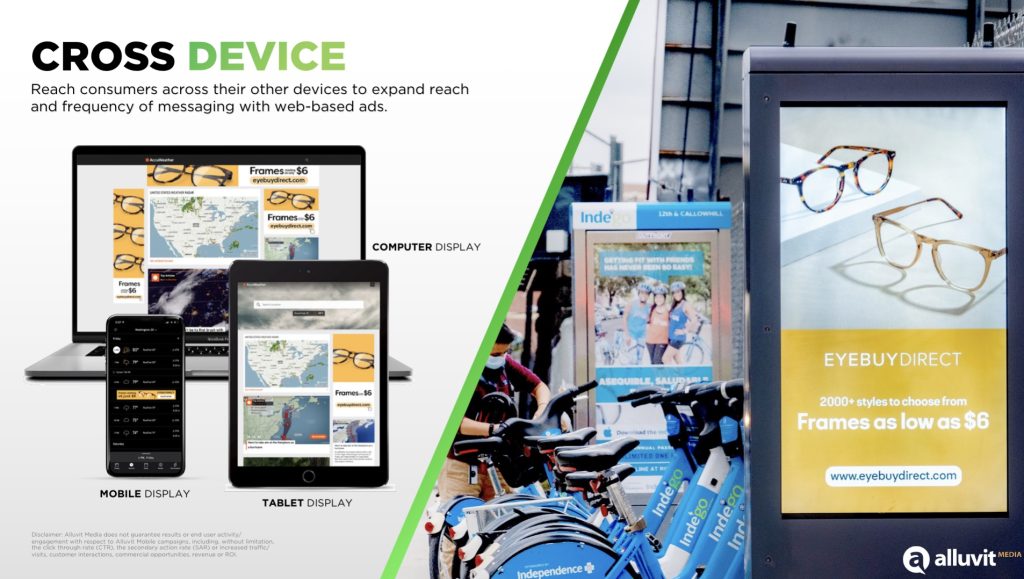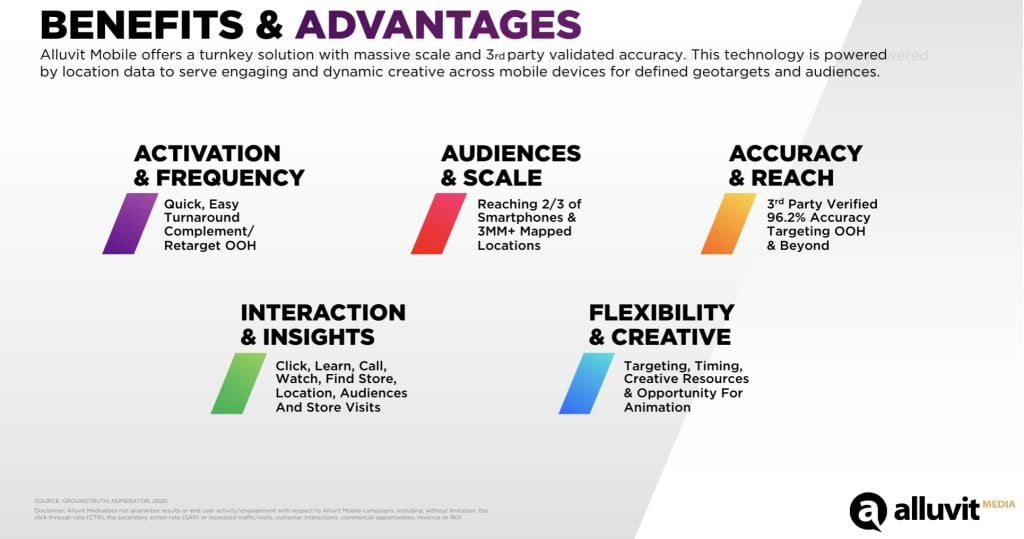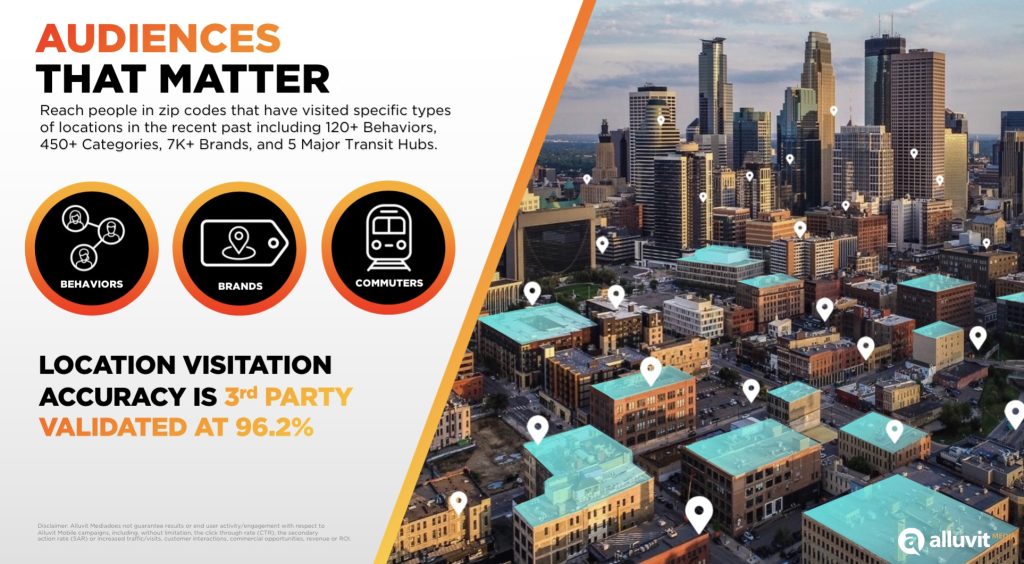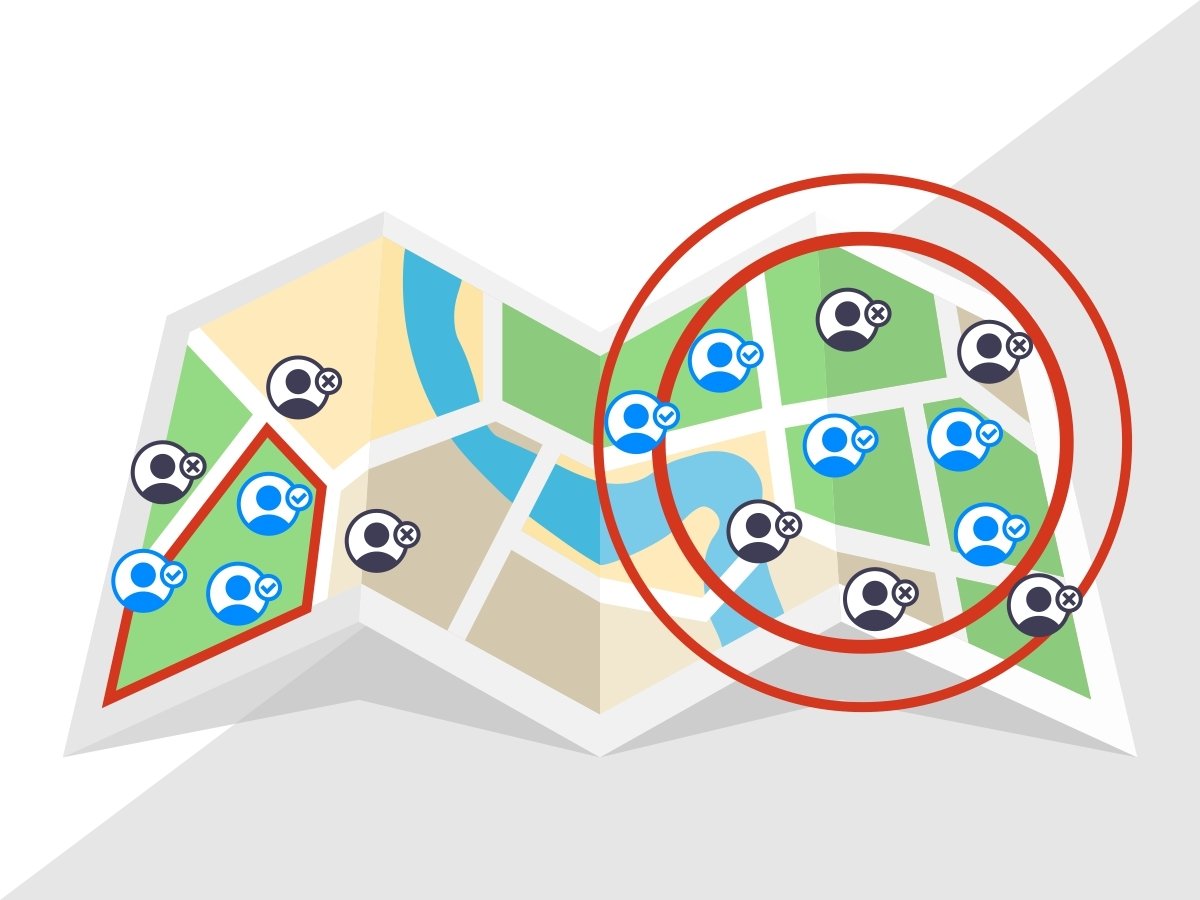By now, many of us know that throwing your message at any unspecified audience and hoping it sticks just won’t cut it. To run marketing campaigns that achieve our objectives, we must tailor our messaging to appeal to a particular set of interests, behaviors, demographics, etc..
That’s where location-based marketing comes into play. Strategies like geofencing and geotargeting allow marketers to deliver targeted messages, promotions, and advertisements to users based on the location shared by their smart device.
Though location-based marketing might arouse concerns around privacy, both geofencing and geotargeting match opted-in, privacy-compliant location data to points of interest — whether it’s a restaurant, shopping mall, event venue, or grocery store. Marketers can then create location-based audiences and data sets for better campaign analytics.
Location-based marketing has proven successful in boosting the effectiveness of marketing campaigns. Of 700 mobile marketers surveyed in a 2019 research study:
- 89% saw increased sales
- 86% grew their consumer base
- 84% engaged customers
In other words, contextually relevant ads are more likely to earn positive results than non-targeted messaging.
So, what about location-based marketing terminology? The most common terms you’ll encounter are geofencing and geotargeting. Though these two terms often get used interchangeably, they have distinct meanings. It’s important to understand how the two can play into your digital marketing strategy.
Read on to learn more about the difference between geofencing vs. geotargeting, the advantages of each, and how you can integrate them into your next campaign.
Here’s what we’ll cover:
- What is geofencing?
- What is geotargeting?
- Advantages of geofencing vs. geotargeting
- How to choose between the two
- OOH + Location-Based Marketing
What is Geofencing?
Geofencing is a location-based marketing technique that creates virtual boundaries (or fences) around physical locations, such as stores, events, or neighborhoods. This strategy relies on the GPS or RFID (radio frequency identification) technology of mobile devices to accurately determine a user’s location.
When someone with a smartphone enters or leaves this virtually defined area, it triggers certain actions, like getting a notification or seeing an ad on their phone. Marketers can leverage a person’s whereabouts to deliver contextually relevant ads. For instance, if someone is near a concert venue, they may be served an ad about upcoming shows at that venue.
What is Geotargeting?
Geotargeting is like a digital bullseye on a map. Unlike geofencing, which relies on virtual boundaries, geotargeting focuses on delivering targeted marketing messages to users based on their specific location, using techniques like GPS coordinates or IP addresses.
The key difference with geotargeting vs. geofencing is that geotargeting hones in on a particular consumer aspect, such as demographics, behaviors, interests, and real-world location. With geotargeting, marketers can create audiences based on historical data. If someone visited a local gym, they may be identified as someone interested in fitness.

Advantages: Geofencing vs. Geotargeting
Both geofencing and geotargeting are powerful tools in the marketer’s toolbox. Both offer unique advantages for reaching and engaging with target audiences. While similar, each strategy has its own set of advantages and limitations.
Geofencing Benefits
- Better Engagement: Geofencing allows businesses to deliver personalized messages or offers to users when they are in close proximity to a physical location, resulting in higher engagement rates.
- Increased Conversions: By targeting users when they are near a store or venue, geofencing enhances the likelihood of conversion as users are more likely to act on the offer due to its immediacy.
- Precise Targeting: Geofencing provides businesses with precise control over their target audience, allowing them to focus their marketing efforts on specific geographic areas and tailor messages accordingly.
- Real-Time Insights: Through geofencing analytics, businesses can gain valuable insights into customer behavior and foot traffic patterns, enabling them to optimize their marketing strategies and make data-driven decisions.
Geotargeting Benefits
- Wide Reach: Geotargeting enables businesses to reach users across different locations, making it ideal for national or global campaigns without the need for setting up physical boundaries.
- Tailored Messaging: Geotargeting allows for highly personalized messaging based on the demographics and preferences of users in specific locations, resulting in increased relevance and effectiveness of marketing efforts.
- Cost-Effectiveness: Compared to geofencing, geotargeting can be more cost-effective as it doesn’t require the setup and maintenance of physical boundaries, and can target users based on broader geographic parameters such as city, region, or country.
- Flexible Targeting Options: Geotargeting offers flexible targeting options beyond physical proximity, including targeting users based on their IP addresses, which can be particularly useful for online advertising campaigns and reaching users across different devices and platforms.

Limitations
- Limited Precision: Unfortunately, location data isn’t perfect. Both geofencing and geotargeting may suffer from imprecise location data, leading to inaccuracies in targeting and triggering actions.
- Reliance on Mobile Devices: Both strategies depend on users having their mobile devices with location services enabled, which can limit effectiveness if users opt-out or have connectivity issues.
- Battery Drain: Constantly monitoring user location for geofencing or geotargeting purposes can drain mobile device batteries faster, potentially impacting user experience.
- Privacy Concerns: Both strategies raise privacy concerns as they involve tracking user movements and sending targeted messages based on location, which some users may find intrusive.
Choosing Between These Two Location-Based Strategies
Now that you better understand the differences between geofencing vs. geotargeting, which one is right for your next campaign? There’s not necessarily a right or wrong option. The option best-suited for you will depend on various factors including your goals, target audience, budget, and more.
Consider the following when deciding which strategy to implement:
Marketing Goals
Start by defining your marketing goals and objectives. Are you looking to drive foot traffic to a physical location, increase brand awareness across multiple locations, or reach a specific demographic segment?
Geofencing may be more suitable if your goal is to target users when they are in close proximity to a physical location, while geotargeting offers a broader reach and can be effective for targeting users across different locations.
Target Audience
Consider the demographics and preferences of your target audience. Are they more likely to be concentrated in specific geographic areas, or are they spread out across different regions?
Geofencing allows for precise targeting of users within defined boundaries, making it ideal for reaching users in specific locations. On the other hand, geotargeting enables you to target users based on broader geographic parameters such as city, region, or country, making it suitable for campaigns with a wider target audience.

Budget and Resources
Evaluate the budget and resources available for your marketing campaign. Geofencing may require setting up physical boundaries and ongoing monitoring of user location, which can incur additional costs. Geotargeting, on the other hand, can be more cost-effective as it doesn’t require the setup and maintenance of physical boundaries and can target users based on broader geographic parameters.
Testing and Optimization
Finally, you may want to consider testing both strategies and analyzing the results to determine which one yields the best ROI for your business. After all, marketing is often about trial and error.
Experiment with different messaging, targeting parameters, and geographic boundaries to optimize the effectiveness of your location-based marketing campaigns.
OOH + Location-Based Marketing

As an out-of-home (OOH) advertising agency, we have to plug the power of outdoor advertising — especially when paired with location-based marketing strategies. Having multiple touchpoints where consumers can view and engage with your ad makes a huge impact.
Imagine this: someone driving down the highway sees a large-format billboard featuring your ad. Later that day, they see the same or a similar ad from your brand on their phone. They recall the billboard they saw earlier. That mental connection strengthens brand recall and increases the likelihood of engagement.
The best marketing campaigns are multi-faceted. Instead of pouring all of your ad dollars into one strategy, consider using a multi-channel approach. Using geofencing or geotargeting, you can virtually reach a specific audience who has already been exposed to your brand in the real world through OOH media. You have the ability to meet people where they are, where they were, and where they’re going with contextually relevant messaging. Now that’s just smart marketing.
